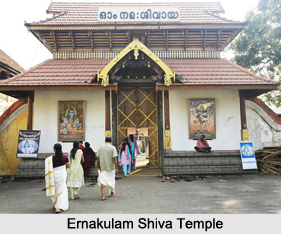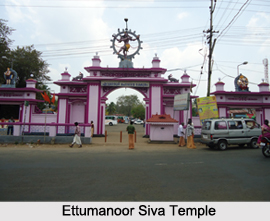 Ernakulam Shiva Temple
Ernakulam Shiva Temple
Location: One of the ancient temples in Central Kerala.
Deity: Lord Shiva also known as `Ernakulathappan` and is the presiding deity of this temple. This is a rare Siva Temple where the deity faces the sea.
Festivals: The annual festival is celebrated for eight days during January-February every year. The festival concludes with the Arattu procession when the image of the deity is taken for a sacred bath in the temple pool and at night there is fireworks. There is a programme of music, classical dance including Kathakali.
Ettumanoor Shiva Temple
Location: 12 km north of Kottayam, this shrine attracts devotees and connoisseurs of art.
Deity: Though the main shrine is dedicated to Lord Shiva the temple houses Bhagavati, Dharma Sastha, Ganapathy and Yakshi.
Architecture: This temple is an excellent example of beautiful and expertly created murals. The themes are from Ramayana and Mahabharata, Upanishads and Puranas. It has a conical gopuram, copper plated roof of the sanctum is awe-inspiring. There are 14 such gopurams in the shrine.
The sculptures and paintings such as the dancing Shiva enhance the appeal of the temple. This temple was renovated in 1542 AD when the famous gopuram and fortress were built around the temple.
 The gold plated flag post has an image of a bull and tiny bells and banyan leaves of metal. The prakram around the sanctum has carved wooden panels. The rear end of the sanctum belongs to Goddess Parvati. There are two idols of the sacred bull Nandi in the mukhamandapam. One of these is made of stone and the other of metal. Towards the entrance is a large bell metal lamp and devotees offer the oil.
The gold plated flag post has an image of a bull and tiny bells and banyan leaves of metal. The prakram around the sanctum has carved wooden panels. The rear end of the sanctum belongs to Goddess Parvati. There are two idols of the sacred bull Nandi in the mukhamandapam. One of these is made of stone and the other of metal. Towards the entrance is a large bell metal lamp and devotees offer the oil.
Legends:
Some say Khara, a demon brother of Ravana set this temple along with two others so all could be visited in a single day. Others say Ettumanoor comes from the word "maan" meaning deer. Lord Shiva himself is said to have created a deer and set it lose on these green soils.
Festival
The Ezharaponnaana Ezhunallathu is the ten-day long annual Festival. It is held during the month of Kumbha (Feb- Mar) and is concluded on the day when the Ardra constellation is on the rise. On the eighth day the Lord`s idol is decorated and placed in a pavilion to the north east of the shrine. The Maharaja of Travancore gifted seven and a half elephants (ezhara pon aana), seven of which are two feet tall and last is one foot tall. These are displayed on this eighth day of the Festival. This temple is also famous for its Thullabharams -. offerings equal to the weight of the devotee. The offerings may be any item pledged - sugar, plantain, gold and silver etc.
How to go: The Ettumanoor temple is easily accessible from the Cochin Airport, 76 kms away and the Thiruvananthapuam International Airport, 152 kms. Rail is linked to the Kottayam Station and road links also connect the city with the rest of the state.





















